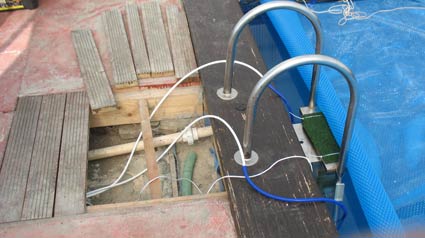 go to HOMEPAGE
or here to go to SOLAR FAQ page Q&A or here for INSTALLATION GUIDE
go to HOMEPAGE
or here to go to SOLAR FAQ page Q&A or here for INSTALLATION GUIDE
Swimming Pools and Solar Heating- A Case Study from around £1000
|
If it is you who pays the bill to heat a pool with Oil, Gas or Electricity you won't need much persuading. A pool is a massive store of energy and the costs of bringing the pool up to temperature and then maintaining this have become prohibitive, to the extent that many people find they are unwilling to commit that expenditure and the expensive pool stops being used. As energy prices continue on their continuous spiral upwards, the value of Solar Heating to replace the fossil fuel reliance has gone from simply desirable to vital. With abundant Solar Energy being available for free, Solar Heat can be the answer. SolarProject has sought to find the simplest (and thus the least expensive) solution to the problem. This DIY installation has been tested on a pool and results have been very encouraging, with the best return on investment available anywhere: |
Considerations:
How Many Panels do I need?
|
The rule of thumb is reckoned to be that the panels' total capture area should be around 25% of the pool's surface area. For a typical pool this equates to two or three of the 20tube, 58mm Evacuated Panels. If the pool is indoor and/or well insulated then less panels will suffice. In our test installation we used two of our 58mm panels. These larger panels offer the best output vs cost ratio. |
 |
Chlorine and Solar Panels
| Most Pool Sterilants react with the copper content of a solar panel, so it is not a good idea to heat a pool 'directly'. The answer is to use a heat exchanger, which is a small box into which two circuits flow, one from the solar panel and the other from the pool. The heat from the solar circuit is transferred to the pool circuit without the two sets of liquids mixing. Until very recently a heat exchanger would cost around £250 but Solarproject has tried and tested a unit available on Ebay at close to £50 which has proved highly effective. |
 |
| Inexpensive Heat Exchanger |
Diagram of the Pool Solar Circuits

| The panels are best mounted on a very slight incline so that any air feeds to the outlet of the last panel, so that airlocks are naturally vented through the header tank. |
Do I need an expansion tank and pressure relief valves?
| No, this is the minimalists dream! The pressure on the Solar Panel circuit is controlled by a small 1 Litre header tank mounted on the top of the panel's manifold. The circuit is filled with antifreeze mixture through this header tank and the level will move up or down to cope with the expansion of fluid as it heats and cools. The pool-side circuit is self controlling because it feeds directly into the pool. Simple and brilliant, nothing to go wrong. |
Pumps and Heat Exchanger
 |
The aim of this installation is simplicity, with minimum initial cost, very low maintenance and almost no running cost. Using 12Volt technology we were able to employ two tiny 8 watt pumps to power the separate circuits. Both are switched from the same controller and use the same power supply. In this shot of the initial layout you can see the two pumps, one circulating water through the panels and the second taking water from the pool, returning it heated. The plumbing to the panels is 10mm copper to manage the higher temperatures, while the pool circuit uses 10mm plastic 'pex' pipe. |
| Initial pumps and exchanger layout (before tidying up!) |
The Pool Circuit
|
In this photo of work in progress you see the two 10mm pipes leading in and out of the pool. Water is circulated to the Heat Exchanger a few feet away and returns to flow at around 2 ltrs per minute. This low flow rate gives a typical constant temperature gain in sunshine of 25 degrees between inlet and outlet. The pipes and pool-probe were later concealed once the installation had been proved and tested. |
 |
go to HOMEPAGE or here to go to SOLAR FAQ page Q&A or here for INSTALLATION GUIDE